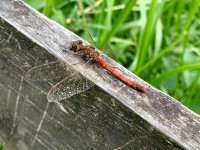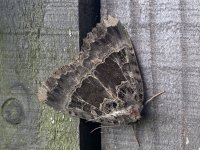JTweedie
Well-known member
Sunny start to the day. Went to Lochwinnoch (notwithstanding public transport problems).
When I got there the weather was really changeable with a few showers.
The reserve felt really quiet today. Unfortunately wasps have taken up residence in the hide overlooking the new scrape. I peeked in to see if I could see where the nest was and I think it was up in the roof and I'd imagine if you're not making wild movements then they'd leave you alone, but I saw them flying around inside and didn't fancy it. There's a fence extending out from the hide though with square windows cut into it, so at least I could still see the scrapes, but I'd not have a seat.
Highlights on the scrape were teal, little ringed plover (nesting here for the first time I believe - which was kept under wraps until the chick(s) appeared), common sandpiper, lapwing, oystercatcher. There's a small group of black-headed gulls on the scrape and in amongst them a Mediterranean gull, a lifer for me.
I spotted two ospreys circling high over Aird Meadow and heading towards Castle Semple Loch. Another person said they saw three ospreys at the same time - he was over on Castle Semple so would have been closer to the birds.
Other highlights include a house martin, many swallows, a few swifts. I saw my first spotted flycatchers of the year. At the feeder there were eight collared doves and a single siskin. I liked seeing the latter as it was unexpected. I used to see them often but since I moved into my flat I don't see them much.
There were lots of young birds around: moorhen, blue/coal/great tit, lapwing, oystercatcher, robin, little ringed plover.
The reserve reported nine different waders on the scrape earlier in the week, so it's obviously a big hit with the birds.
When I got there the weather was really changeable with a few showers.
The reserve felt really quiet today. Unfortunately wasps have taken up residence in the hide overlooking the new scrape. I peeked in to see if I could see where the nest was and I think it was up in the roof and I'd imagine if you're not making wild movements then they'd leave you alone, but I saw them flying around inside and didn't fancy it. There's a fence extending out from the hide though with square windows cut into it, so at least I could still see the scrapes, but I'd not have a seat.
Highlights on the scrape were teal, little ringed plover (nesting here for the first time I believe - which was kept under wraps until the chick(s) appeared), common sandpiper, lapwing, oystercatcher. There's a small group of black-headed gulls on the scrape and in amongst them a Mediterranean gull, a lifer for me.
I spotted two ospreys circling high over Aird Meadow and heading towards Castle Semple Loch. Another person said they saw three ospreys at the same time - he was over on Castle Semple so would have been closer to the birds.
Other highlights include a house martin, many swallows, a few swifts. I saw my first spotted flycatchers of the year. At the feeder there were eight collared doves and a single siskin. I liked seeing the latter as it was unexpected. I used to see them often but since I moved into my flat I don't see them much.
There were lots of young birds around: moorhen, blue/coal/great tit, lapwing, oystercatcher, robin, little ringed plover.
The reserve reported nine different waders on the scrape earlier in the week, so it's obviously a big hit with the birds.








